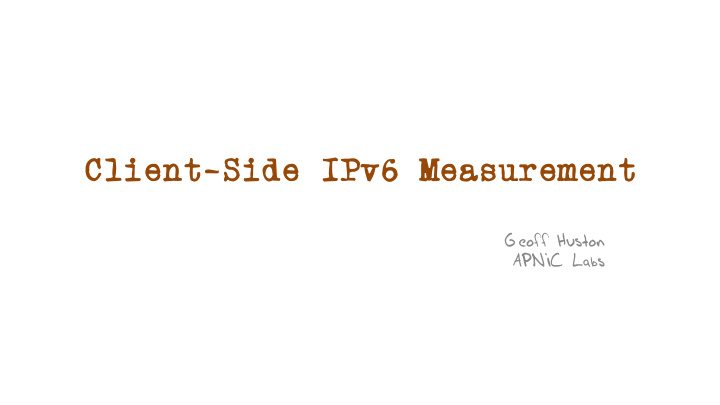



Client-Side IPv6 Measurement Geoff Huston APNIC Labs
How to measure millions of end devices for their IPv6 capability?
How to measure millions of end devices for their IPv6 capability? Be
How to measure millions of end devices for their IPv6 capability? OR Have your measurement code run on millions of end devices
APNIC’s Approach • we wanted to measure IPv6 deployment as seen by end users • We wanted to say something about ALL users • So we were looking at a way to sample end users in a random but statistically significant fashion • We stumbled across the advertising networks...
The Ad Measurement Technique Ad Server Authoritative Name Server End user Web Server
The Ad Measurement Technique Ad Server 1. Ad Impression Authoritative Name Server End user Web Server
The Ad Measurement Technique Ad Server 2. DNS resolution DNS Authoritative Name Server Resolvers End user Web Server
The Ad Measurement Technique Ad Server Authoritative Name Server End user Web Server 3. Web Fetch
The Ad Measurement Technique Ad Server Authoritative Name Server End user Web Server 4. Result Web Fetch
What can be scripted • Not much: – http.FetchImg() i.e. attempt to retrieve a URL But that’s enough! • It’s EXACTLY what users do! – A URL consists of a DNS question and an HTML question – – What if we point both the DNS and the HTML to servers we run? As long as each Ad execution uses unique names we can push the user query – back to our servers
Tests Think of a URL name as a microcoded instruction set directed to programmable DNS and HTTP servers … http://06s-u69c5b052-c13-a0461-s1579128735-icb0a3c4c-0.ap.dotnxdomain.net/v61x1.png Valid DNS IPv6 access only Valid DNSSEC signature available User is located in Country 13 (Australia) User is in AS1221 (Telstra) Time is 16 January 2020 9:52am User’s IPv4 address is 203.10.60.76
Ad Placement At low CPM, the advertising network needs to present unique, new eyeballs to harvest impressions and take your money. – Therefore, a ‘good’ advertising network provides fresh crop of unique clients per day
Unique IPS? • Collect list of unique IP addresses seen – Per day – Since inception • Plot to see behaviours of system – Do we see ‘same eyeballs’ all the time?
Lots of Unique IP’S Unique IPs via Ads Unique IPs via Web Sites
Ad Presentation Volumes
Ad Presentations: Countries
Bias Compensation • The ad presentation is NOT uniform across the Internet’s user population – The ad machinery ‘over-presents’ in some countries:
Bias Compensation • The ad presentation is NOT uniform across the Internet’s user population – The ad machinery ‘under-presents’ in some countries:
Bias Compensation • Use ITU data on Internet users per country as the reference set, and weight the ad results to compensate for ad placement bias
Dealing with the data • Unified web logs, dns query logs, packet capture • Map individual DNS and HTML transactions using a common experiment identifier • For example: – DNSSEC validation implies: • DNS queries include EDNS(0) DNSSEC OK flag set • See DNS queries for DNSSEC signature records (DNSKEY / DS) • User fetches URL corresponding to a validly signed DNS name • User does not fetch URL corresponding to a in validly signed DNS name
What are we measuring? • IPv6 Adoption • IPv6 Dual Stack Preference • IPv6 Performance • IPv6 FragmentationExtension header fragility •
What are we seeing?
IPv6 Adoption by Country
IPv6 Adoption and Preference
IPv6 Preference
IPv6 Performance
IPv6 Reliability
But… It’s not a general purpose compute platform, so it can’t do many things – Ping, traceroute, etc – Send data to any destination – Pull data from any destination – Use different protocols This is a “many-to-one” styled setup where the server instrumentation provides insight on the inferred behaviour of the edges
Measurement Ethics • There is no user consent • And cookies (even “don’t measurement me!” cookies) are progressively being frowned upon • Don’t generate large data volumes • Don’t publish PII • Don’t use ‘compromising’ URL names
In Summary… • Measuring what happens at the user level by measuring some artifact or behaviour in the infrastructure and inferring some form of user behaviour is always going to be a guess of some form • If you really want to measure user behaviour then its useful to trigger the user to behave in the way you want to study or measure • The technique of embedding simple test code behind ads is one way of achieving this objective – for certain kinds of behaviours relating to the DNS and to URL fetching
Recommend
More recommend